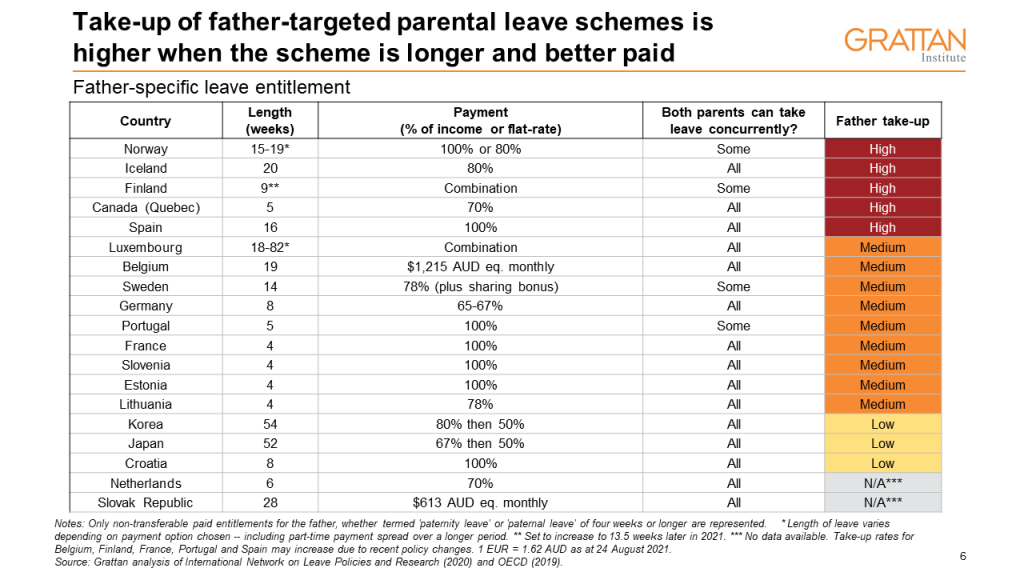The 2022 federal budget spruiks an ‘Enhanced Paid Parental Leave’ scheme that will ‘remove barriers to women’s workforce participation’. But the budget measure is small change: it doesn’t extend the amount of leave available, it just tweaks the rules. The loss of a use-it-or-lose-it component for each parent could even take Australia further away from gender-equal sharing of parenting, missing an opportunity for big social and economic benefits.
The main change announced in the budget is that the 18-week Parental Leave Pay (PLP) and the 2-week Dad and Partner Pay (DAPP) will be rolled into a single 20-week package, which can be used by either parent, or shared.
On the plus side, this could make it a bit simpler for fathers to use a large portion of the family’s leave allowance. No longer will a separate process be required for Mum to transfer part of her PPL allowance to Dad. This change also means fathers will be able to get government PPL while on paid leave from their employer, as mothers can do currently, which removes the need to negotiate unpaid leave from an employer.
But without an increase in the total leave allowance, it’s unlikely we’ll see a more gender-equal sharing of leave. At present, 99.5 per cent of Parental Leave Pay is taken by mothers (see chart). Many new fathers are keen to take more leave, but it will be hard for them to justify eating into the 18-week allowance mothers can take now. Instead, it will now be possible (and probably simpler administratively) for Mum to take the full 20 weeks herself, cutting out Dad entirely.

There is a good case for more parental leave for mothers, but if this comes at the expense of leave for their partner, then the prospects for sharing the caring load are grim.
Caring habits formed in the early years of a child’s life tend to persist. And when fathers do more of the caring, both parents benefit. Evidence from many countries shows the mental and physical health of both parents is better when fathers are more involved. Parents are less stressed, and they’re more likely to stay together.
Children do better too. Children with two involved parents – be it two men, two women, or one of each – have, on average, greater cognitive ability, superior emotional development, and better social skills.
And there are also economic benefits. When fathers are more hands-on, it can free mothers to head back to work, and to work more hours. This improves economic security for those mothers, but also benefits the country.
Much of the world is moving towards parental leave schemes that specifically encourage fathers and partners to be more involved in caring early on. Most OECD countries now have a specific leave entitlement for fathers or partners of at least four weeks (see table). Indeed, a non-transferable allocation for each parent is now an EU requirement. But Australia will be moving in the other direction if the paltry two-week non-transferable leave fathers have now becomes subsumed into the main package.

There are some welcome components of the revised rules. The inclusion of a family income threshold so female-breadwinner families are treated the same as male-breadwinner families is long overdue. The opportunity to take leave at any point in the first two years provides families with more flexibility. And an extra two weeks’ leave allowance for single parents is a small but significant step in the right direction.
But what would it take to really move the dial?
Firstly, the government should add six weeks to the current 18-week parental leave allowance as a ‘use it or lose it’ component for fathers or partners. To encourage leave sharing, this should be done through a 6/12/6 structure – six weeks for each parent, and 12 to share between them as they choose.
To supercharge the scheme, we also recommend an additional two weeks of bonus leave – which could be used by either parent – if both parents take at least six weeks leave. This would send a powerful message that the government is willing to devote money to encouraging parents to share leave. Single parents should get the full 26 weeks.
We estimate our proposed scheme could cost the federal budget $600 million a year if it attracts good take-up. But it would lead to an increase in GDP of $900 million a year, because more women would be freed up to engage in more paid work. Add that to the longer-term benefits of more satisfied parents, better children’s development, and greater gender equality, and it’s a very worthwhile investment.
While you’re here…
Grattan Institute is an independent not-for-profit think tank. We don’t take money from political parties or vested interests. Yet we believe in free access to information. All our research is available online, so that more people can benefit from our work.
Which is why we rely on donations from readers like you, so that we can continue our nation-changing research without fear or favour. Your support enables Grattan to improve the lives of all Australians.
Donate now.
Danielle Wood – CEO
